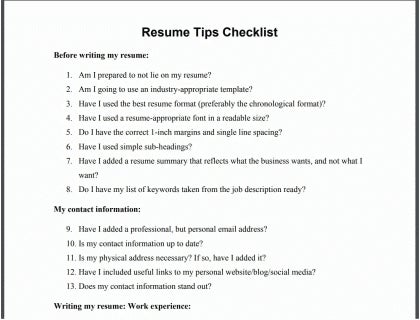
Resume Tips Checklist - Free PDF Download
Download this free resume tips checklist in PDF format and keep it with you as you write your resume.
Download NowTop Resume Writing Tips:
We've included our best tips for when you are writing your resume in an easy-to-follow format that will help you through the different stages of writing.
1. Don't lie on your resume.
This is the most important tip when it comes to writing a resume because if you lie, you will be caught, whether it's in the interview or after you've been hired.
2. Consider a template.
Using a resume template or builder can save you a lot of time and effort. While you have a predesigned platform, you can still customize it to suit your personal needs.
If you do choose to use a template, choose one that reflects your industry. Most resume builders will allow you to search for templates by industry.
3. Choose a format that works for you.
There are a few basic types of resume formats that work for different job types and levels, including:
Take a look at the different formats, but keep in mind that the chronological resume is usually the best choice.
4. Choose a great font.
Use a basic, modern font that is clear and easy to read, such as Arial, Helvetica, or Calibri. A font that is difficult to read or childish in appearance may cause the hiring manager to throw your resume out without trying to read it.
You will also make it easier on the recruiter if you keep your font size to between 10 and 12 points, depending on how much information you are including in your resume.
5. Set your margins.
It's important to balance your text and white space on your resume to improve readability for the recruiter and to keep your resume looking professional, neat, and clean. Typically, margins should be 1 inch each with single-line spacing. If you need more text space, you can drop your top and bottom margins to half an inch and your side margins to 0.75 inches.
Do not be tempted to remove all your white space so that you can fit more text onto 1 page. However, you also don't want to have too much white space (refer to point 34).
6. Use simple subheadings.
Don't try to be fancy by using complicated subheadings. Stick to things like "experience," "education," and "skills" to make your different sections easy to find. If you find it difficult to list more than 2 bullet points under a particular section, consider combining it with another.
If there are sections you do not need, then remove them from your resume. For example, if you have not worked before and are applying for your first job, remove the work history section rather than including a blank section. You can always replace a section with something else, like coursework, academic achievements, or extracurricular activities.
7. Consider adding a resume summary.
An important tip for resume writing is to make the best use of the top third of your resume page. This top section is usually what recruiters see first, so you should highlight your best experiences, skills, and accomplishments here. The resume summary should be three sentences about who you are and what you hope to achieve or bring to the company.
However, you should only add a resume summary if you need to add important information that hasn't been listed elsewhere on your resume. You should also not add a resume objective at all, as most recruiters agree that it is unnecessary.
8. Go over the job description.
Carefully read through the job posting that you want to apply for and pick out keywords that show what the recruiter is looking for. In particular, pay attention to key skills and requirements listed in the requirements and qualifications sections of the job description. Make a list of the keywords you find so that you can include them in your resume.
If you are stuck and can't pick out keywords in the job description, put it through a cloud generator.
Your contact information.
These tips will help you to correctly format and highlight your contact information.
9. Use a professional email address.
Take the time to create a professional-looking email address with your full name, using Gmail or Outlook. For example, jane.smith@gmail.com. Do not use your current work email address, your college email address, or an overly personal one on your resume.
10. Update your contact information.
First off, check that your name is spelled correctly. Mistakes happen. Make sure all your contact information is up to date, especially your phone number and email address. You don't need to include details like your marital status or birth date, but you do need to ensure the recruiter can contact you.
11. Consider whether your physical address is necessary.
If you are applying for a job near to you, you can add your physical address to show that you are in the area and available. However, if you are applying to jobs in other states, leave out your address so that the recruiter won't think you're confused about the job you're applying for. Some recruiters are also not too enthusiastic about hiring people who need to move in order to do the job.
12. Include relevant links or URLs.
Include professional website or blog URLs in your contact section as well as any relevant social media handles, like LinkedIn, X, or Instagram. Of course, any social media profiles you link in your resume should be professionally acceptable and should be consistent with your resume.
13. Make sure your contact information stands out.
Make sure your contact information stands out at the top of your resume page by using a different font from the body of your resume or using bold or italics. If you choose to use a different font, make sure it's a clear, easy-to-read resume font. However, do not add a photo to your contact information.
14. Use reverse-chronological order.
When listing previous work experience, start with your most recent job and work backward from there.
15. Keep your work experience brief.
While you may have years of experience working at a wide variety of different jobs, not all of them will be relevant to the job you are applying for. When listing previous work experience, don't go back more than 10 or 15 years.
16. Keep explanations achievement-oriented, not result-oriented.
When describing your work roles, illustrate a skill or responsibility with achievements. Start with the most important information in your bullet lists to draw attention to your key achievements. Use the X, Y, Z approach:
In situation X, I did Y, which resulted in Z.
It is also important to keep your explanations concise with a maximum of 6 bullet points.
17. Quantify your achievements.
When listing your responsibilities and achievements, try to quantify them by adding numbers where possible. This includes any facts, figures, or numbers that help recruiters to picture the level of responsibility you achieved.
18. List your promotions.
Draw attention to any promotions you received by listing the various titles with accompanying responsibilities. You only need to list the company name once.
19. Add a short description for large gaps in your work history.
Whether you took a break, were laid off, had a child, or went back to school, there are all sorts of reasons why there might be a significant break in your work history. Include a brief explanation to show recruiters why the break was necessary, beneficial to you, or unintentional.
20. Don't use a lot of jargon.
Don't be tempted to use a lot of industry jargon in your resume, as the hiring manager, recruiter, or assistant who reads your resume might not have the relevant education and experience to understand. Instead, make your resume readable, relevant, and understandable to all.
21. Use active language.
Your resume sections should be written in the active voice using action verbs. This can help you to make your sentences short, concise, and impactful. Using action verbs can also help your resume to stand out from your competition by avoiding overused resume buzzwords, like "responsible for" or "managed" and replacing them with stronger verbs.
22. Include nontraditional work.
If you have any volunteer, part-time, temporary, contract, or freelance work experience that is relevant to the job you are applying for, add that to your work experience section.
23. Include your list of keywords from the job description.
Include some of the keywords you found in the job description in your resume. This ensures that you are properly tailoring your resume to the job at hand and will get your resume noticed in any applicant tracking system (ATS). However, don't go overboard with the keywords, or recruiters will think you are just 'fluffing' up your resume.
24. If you don't have work experience, replace this section with something else.
If you don't have work experience at all or any that is relevant to the job at hand, remove this section rather than leaving it blank or filling it with 'fluff.' Focus instead on your academic achievements and any relevant or transferable skills.
25. Consider where your education should be in your resume's layout.
Generally, you would put work experience first, followed by education. However, if you are a student who lacks a lot of work experience, you should consider putting your education section first.
26. Use reverse-chronological order and don't add dates.
List your highest degree first and work backward from there. However, if you have older coursework that is more relevant to the job, list it first to grab the recruiter's attention. You also do not need to include any graduation dates as they are not really relevant unless you have graduated very recently.
27. Highlight your honors.
While it's not necessary to list your GPA, if you achieved high honors in college, such as summa cum laude or being in an honors college, you should definitely highlight them in your resume.
28. Include online education.
Don't be afraid to add any continuing education, professional development coursework, or online courses that you are currently doing.
29. Consider adding descriptions of your coursework.
If you are still a student or a recent graduate, your education section is your strongest selling point as your work experience will likely be negligible. Consider adding coursework descriptions to your resume that can show recruiters that you have skills relevant to the job you are applying for.
Coursework descriptions can also be useful for experienced professionals who are considering a change in career. In this case, you can show recruiters that you have skills and knowledge beyond your recent work experiences.
30. Highlight your most relevant skills.
Be sure to list a skills section and highlight the skills that are most relevant to the job you are applying for, including any tech skills and industry-related certifications.
31. Skip adding generic skills.
Rather don't list generic skills that anyone has, like using email or being hard-working or detail-oriented. Most candidates will have these skills, so rather list ones that make you stand out.
32. Create subsections.
If you have a lot of skills that are related to the job you are applying for, break them up into individual subsections. For example, you could have a software skills section where you list all of your software skills that are related to the job. Then you can follow this with a leadership skills section, and list the experiences that led to this skill.
33. Include any awards you've achieved.
Include any work-related awards that you have received, such as top sales record for the month. You can also list personal achievements that are not strictly relevant to the job in question, but that demonstrate a soft skill, such as determination, motivation, or being a hard worker.
34. Consider adding a section on your hobbies and interests.
Some companies are beginning to emphasize work culture. If you have a lot of white space on your resume, adding hobbies and interests that match the company's culture can give the recruiter an idea of your personality. You should also include any hobbies or interests that highlight positive personality traits and relevant skills.
Do not add any religious, political, or sexual interests to your resume. While running a fundraising event for your church may demonstrate great soft skills, it could actually hurt your chances of getting the job if the recruiter disagrees with the cause or your views.
35. Make sure your resume is no longer than two pages.
Ideally, a resume should be one page long, but for those with a lot of work experience, it can be up to two pages. Go over your resume to remove any unnecessary information, make your sentences short and concise, or decrease your font size (no less than 10pt) to keep your resume length appropriate.
36. Consider removing short-term jobs.
If you were only at a particular workplace for a few months, consider removing it from your resume. This will free up space for more relevant work experiences. Just remember to be honest if asked about any short-term jobs in your interview.
37. Hide short-term work gaps by removing the months.
Removing the months from your start and end dates is a neat strategy to hide short-term gaps where you were out of work for a few weeks or months. Instead, only list the start and end years or else the number of years and months that you worked at your previous jobs.
38. Explain instances of job-hopping.
If you have had a period of time where you changed jobs frequently, you can make this job hoping less of an issue for recruiters by giving a reason for leaving each job. Examples of reasons include downsizing, company closures, or relocations.
39. Remove instances of creative padding.
For example, if you took time off from working to raise your children, it is unprofessional to add your parenting experience to your resume. For example, "successfully coordinated daily toy-room cleanups." Corporate recruiters will not take you seriously if they see this.
This also applies to job titles. Don't try to make your previous roles seem more important by using an inventive job title instead of a simple one. If you worked as a barman, say so.
40. Remove "references available on request."
It is no longer necessary to include this phrase on your resume. If a recruiter is interested in you, they will ask for references. Adding this phrase just takes up space that could be used for more important information.
41. Consider using a cloud generator.
A cloud generator is a tool for quickly spotting trends and patterns through the generation of a word cloud (or a tag cloud). The word cloud will show keywords in different sizes that indicate how often they appear in the uploaded document.
If you ran the job description through a cloud generator before you wrote your resume, consider running your completed resume through the same cloud generator to check that you've tailored your resume to the job description.
42. Proofread your resume.
Your resume should be free of all typos and grammar issues. While you should use a proofreading program or tool, such as Grammarly, you should also proofread your resume yourself. It is also very helpful to ask a friend, family member, or colleague to proofread your resume as we don't also catch small issues when rereading our own work for the fifth time.
When proofreading your resume, be sure to check that you have not used any personal pronouns, have written numbers correctly (1-9 spelled out, 10 and above written numerically), and have used punctuation consistently, especially in your bullet points.
43. Consider saving as a PDF.
Saving your resume as a PDF ensures that the format will not change when it is opened, but PDFs don't always work well with ATS.
44. Include the proper name on your files.
It is very important to name your resume files properly. Instead of just naming it "resume," include your name so that your resume does not get lost.
45. Match your cover letter to your resume.
Write a cover letter that matches the information in your resume. Your cover letter is also a great place to include more thorough descriptions of work experience, education, or skills that you feel need a deeper explanation.
46. Follow the recruiter's instructions when emailing your resume.
The recruiter may want your resume to be sent in a particular format or in a specific way. Make sure you follow their instructions and include all the required attachments and information.
47. Always update and refresh your resume.
Update your resume every 4 months or so with any new responsibilities, skills, experiences, or awards you have gained.
48. Consider using a unique resume for different job applications.
If you are applying for a variety of jobs, you should use a unique resume that is specifically tailored to each job application.
49. Write thank you emails.
Writing a thoughtful thank you email after an interview is a great closing to acing your resume and interview process.
50. Clean up your social media accounts.
Hiring managers may also search for you online, so be sure to change your Facebook privacy settings to "Friends" and clean up any other social media accounts so that they are professionally acceptable. Also, Google your name and check what comes up. You can ask Google to remove sensitive, personal, or sexual information.
How to Create the Perfect Resume


